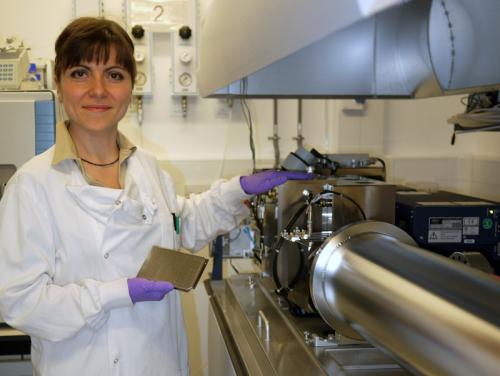
Researchers develop new method for drug discovery in the ubiquitin field
The potential to develop new drugs to target a class of enzymes which are implicated in major diseases such as cancer and neurodegenerative conditions has been boosted with the development of a new drug discovery method in a research effort performed by Stella Ritorto in Matthias Trost's laboratory
Stella and her collaborators have been examining the class of enzymes called deubiquitylases (DUBs). Around 90 DUBs have been identified in the human genome and they are active in almost every process in cells.
Drugs that target components of the ubiquitin system are predicted to become of major importance to the pharmaceutical industry in the future. However, until now it has proved difficult to carry out sufficiently detailed and accurate mass testing of compounds against specific DUBs.
Now the team led by Dr Matthias Trost in the MRC-PPU with collaborators from the Dario Alessi lab (MRC PPU) and the Nathanael Gray lab (Harvard Medical School) have developed a new drug discovery method using MALDI TOF mass spectrometry that will allow greater analysis of the activity of specific DUBs and how they react to treatment with drug compounds.
'This is the first method which allows us to carry out high-throughput screening of DUBs, which is essential if we are going to be able to identify new drug targets and develop new drugs. This is why major pharmaceutical companies, many of whom we work with, are very excited about this because it opens new avenues of drug development in this area,' said Dr Trost.
Dario Alessi, Director of the MRC-PPU and a co-author on the paper stated 'Stella Ritorto has worked incredibly hard and done an awesome job in setting up the MALDI-TOF DUB assay. The key advantage of Stella's assay is that it enables DUB activity to be assessed in a high-throughput manner for the first time employing more physiological non-chemically modified di-ubiquitin substrates, in contrast to existing methodology that makes use of artificial chemically modified ubiquitin derivatives. There is increasing interest in developing specific DUB inhibitors not only to better treat diseases such as cancer, Parkinson's and immunological disorders, but also to explore the biological processes that these fascinating enzymes control. I hope that the MALDI-TOF DUB assay that Stella has developed will enable researchers to easily undertake high-throughput screens for DUB inhibitors employing physiological unmodified di-ubiquitin substrates. Just as importantly, it will enable the substrate specificity of the DUB inhibitors to be rapidly assessed against a panel of ~35 other DUBs. This should accelerate efforts to develop highly selective and potent DUB inhibitors. We would urge any group with an interest in developing specific DUB inhibitors to get in touch with us to discuss the evaluation of the selectivity of their compounds using the MALDI-TOF DUB assay'
The results of the research are published today in Nature Communications.
Stella and her collaborators have been examining the class of enzymes called deubiquitylases (DUBs). Around 90 DUBs have been identified in the human genome and they are active in almost every process in cells.
Drugs that target components of the ubiquitin system are predicted to become of major importance to the pharmaceutical industry in the future. However, until now it has proved difficult to carry out sufficiently detailed and accurate mass testing of compounds against specific DUBs.
Now the team led by Dr Matthias Trost in the MRC-PPU with collaborators from the Dario Alessi lab (MRC PPU) and the Nathanael Gray lab (Harvard Medical School) have developed a new drug discovery method using MALDI TOF mass spectrometry that will allow greater analysis of the activity of specific DUBs and how they react to treatment with drug compounds.
'This is the first method which allows us to carry out high-throughput screening of DUBs, which is essential if we are going to be able to identify new drug targets and develop new drugs. This is why major pharmaceutical companies, many of whom we work with, are very excited about this because it opens new avenues of drug development in this area,' said Dr Trost.
Dario Alessi, Director of the MRC-PPU and a co-author on the paper stated 'Stella Ritorto has worked incredibly hard and done an awesome job in setting up the MALDI-TOF DUB assay. The key advantage of Stella's assay is that it enables DUB activity to be assessed in a high-throughput manner for the first time employing more physiological non-chemically modified di-ubiquitin substrates, in contrast to existing methodology that makes use of artificial chemically modified ubiquitin derivatives. There is increasing interest in developing specific DUB inhibitors not only to better treat diseases such as cancer, Parkinson's and immunological disorders, but also to explore the biological processes that these fascinating enzymes control. I hope that the MALDI-TOF DUB assay that Stella has developed will enable researchers to easily undertake high-throughput screens for DUB inhibitors employing physiological unmodified di-ubiquitin substrates. Just as importantly, it will enable the substrate specificity of the DUB inhibitors to be rapidly assessed against a panel of ~35 other DUBs. This should accelerate efforts to develop highly selective and potent DUB inhibitors. We would urge any group with an interest in developing specific DUB inhibitors to get in touch with us to discuss the evaluation of the selectivity of their compounds using the MALDI-TOF DUB assay'
The results of the research are published today in Nature Communications.

